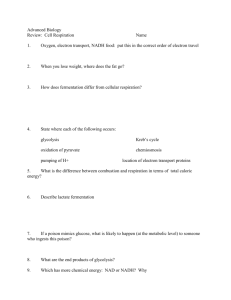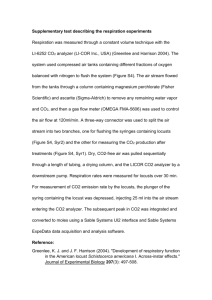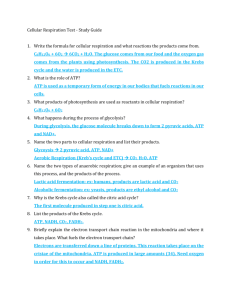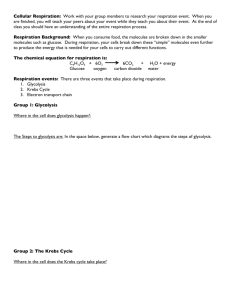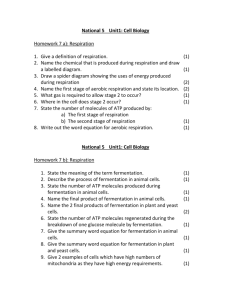Metabolism: Dissimilatory (energy, catabolic) metabolism
advertisement
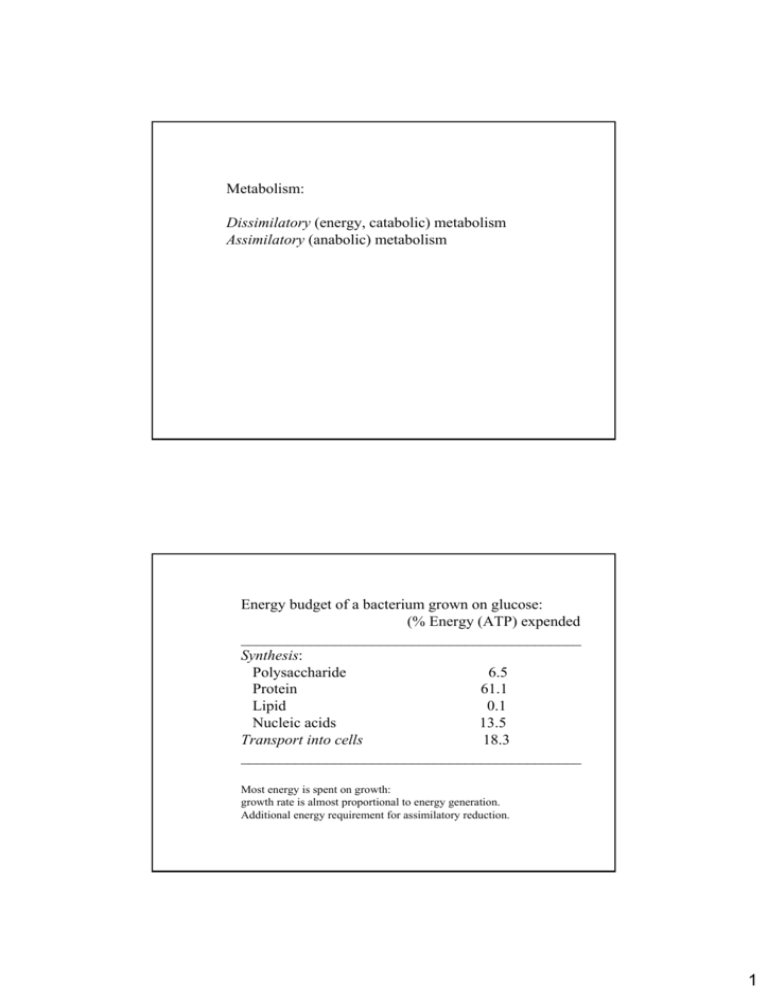
Metabolism: Dissimilatory (energy, catabolic) metabolism Assimilatory (anabolic) metabolism Energy budget of a bacterium grown on glucose: (% Energy (ATP) expended ____________________________________________ Synthesis: Polysaccharide 6.5 Protein 61.1 Lipid 0.1 Nucleic acids 13.5 Transport into cells 18.3 ____________________________________________ Most energy is spent on growth: growth rate is almost proportional to energy generation. Additional energy requirement for assimilatory reduction. 1 Autotrophy: solely dependent on inorganic compounds Heterotrophy: dependent on organic substrates Distinction rarely absolute: ”autrotrophs” may require organic growth factors (vitamins). Usually refers to carbon source for assimilatory metabolism (autotrophs depend on C-1 compounds, that is CO2 or CH4). Photoautotrophs use light as energy source Chemoautotrophs depend on the oxidation of inorganic compounds as energy source. Metabolism depends on redox processes of the type AH2 + B → BH2 + A Coupled to ATP synthesis: ADP + Pi + energy → ATP + H2O Substrate level phosphorylation: 1 mol ATP generated per mole substrate. Electron transport phosphorylation 2 Fermentation: Redox balance Substrate phosphorylation Dismutation of organic substrate (e.g. C6H12O6 → 2CH3·CHOH·COOH) Anaerobic processes Low energy yield Respiration: External electron acceptor Electron transport system Organic or inorganic susbstrates Electron transport system Methanogenesis: CH3COOH → CH4 + CO2 CO2 + 4H2 → (formally a fermentation process) CH4 + 2H2O (formally a respiration process) Phototrophy: Cyclic phosphorylation (but dependent on org. C for assimilatory metabolism). Photosynthesis: uses energy + external electron donor to reduce CO2 to organic matter. 3 Fermentation Fermentation to lactate or ethanol: Mixed acid fermentation: Fermentation to butyrate and to acetate 4 Other types of fermentation: Propionic acid fermentation Stickland reaction (fermentation of amino acids) Thiosulphate disproportionation: S2O32- + H2O → SO42- + HS- + H+ Homoacetogens: CO2 + 4H2 → CH3COOH + 2H2O Respiration: Aerobic respiration: O2 is the terminal electron acceptor. Substrates: all kinds of organic matter, depending on presence of hydrolytic enzymes, reduced inorganic molecules (e.g., H2, HS-, NH4+, Fe2+, etc) Anaerobic respiration: other electron acceptors (e.g., NO3-, Fe3+, SO42-, etc). Substrates: usually only low molecular weight compounds (volatile fatty acids), H2) 5 Aerobic respiration – organic substrate: (Hydrolysis) → Glycolysis → Citric acid cycle →Electron transport system Chemoautotrophs: Hydrogen oxidisers (knallgas bacteria): 2H2 + O2 → H2O Methane oxidisers: CH4 + 2O2→ CO2 + 2H2O (Methylobacter, etc) Nitrifiers: 2NH4+ + 3O2 → 2NO2- + 4H+ + 2H2O (Nitrosomonas) 2NO2- + O2 → NO3(Nitrobacter, etc.) Sulphide oxidisers: HS- + 2O2 → SO42- + H+ (Thiobacillus, Beggiatoa, etc.) (So and S2O32- occur as intermediate metabolites) Fe and Mn oxidisers: 4Fe2+ + O2 + 4H+ → 4Fe3+ + 2H2O 6 Anaerobic respiration Possible electron acceptors: NO3-, NO2-, (denitrification, principal end product: N2) Fe3+, Mn4+ (end product: Fe2+, Mn2+) SO42- , So, (sulphate reduction, endproduct: HS-1) Amanox-reaction: NO2- + NH4+ → N2 + 2H2O Some organic electron acceptors (e.g., trimethyl amine oxide that is reduced to trimethylamine) 7 Denitrification: Sulphate reduction in Desulfovibrio Substrates: e.g., H2,lactate, but not acetate Acetate utilisation requires a citric acid cycle, e.g. in Desulfobacter 8 Methanogenesis Acetoclastic- CO2 + H2- methanogenesis Phototrophy: Oxygenic photosynthesis: CO2 + 2H2O + light → (CH2O) + O2 + H2O (cyanobacteria, chloroplasts) Two photosystems, chlorophylls + accessory pigments Anoxygenic photosynthesis: CO2 + 2H2S + light → (CH2O) + 2S + H2O One photosystem, bacteriochlorophylls, various electron acceptors (HS-1, H2, Fe2+) Several unrelated groups of bacteria. Purple membrane (halophilic archaebacteria, perhaps wider occurrence). 9 10 Diversity among phototrophs: Oxygenic phototrophs: Cyanobacteria: Chorophyll a (b), Phycobillins (phycocyanin, phycoerythrin, photosystem I+II Anoxygenic phototrophs: Single photosystem, various electrondonors. Purple sulphur bacteria (HS-, So, bacteriochorophyll a or b) Purple non-sulphur bacteria (H2, Fe2+, HS-, bacteriochlorophyll a or b) Green sulphur bacteria (HS-, bacteriochlorophyll c or d, strict anaerobes) Green non-sulphur bacterua (H2, HS-, multicellular filamentous forms, bacteriochlorophyll c or d) Heliobacterium (H2, bacteriochlorophyll g) 11 Assimilative metabolism A bacterial cell contains about 70% H2O Dry weight composition (%): C: 55 O: 20 N: 10 H: 8 P: 3 S: 1 Remaining each <1% Protein: 55%, Nucleic acids 23%, lipids, polysaccharides, monomers 22% 12 Principal mineral forms: In oxic habitats In anoxic habitats _________________________________ C CO2 CO2, CH4 N NO3 , NO2 ,N2 NH4+, N2 2S SO4 So, HSP PO43PO43__________________________________________________ Inorganic carbon assimilation: Calvin cycle: most chemoautotrophs, purple bacteria, cyanobacteria Inverse citric acid cycle: green sulphur bacteria, some Archaebacteria Synthesis of acetyl-CoA: sulphate reducers, H2/CO2 acetogens, methanogens Via HCHO: methanotrophs N2-fixation: Depends on dinitrogenase and denitrogenase reductase. The latter (Fe and Mo containing) enzyme is O2-sensitive. N2-fixation is energetically costly (18-24 ATP per N2). Widespread among anaerobic bacteria and aerobes (cyanobacteria, Azotobacter) with special adaptations for creating anaerobic conditions. 13
